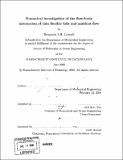| dc.contributor.advisor | Dick K.P. Yue. | en_US |
| dc.contributor.author | Connell, Benjamin S. H | en_US |
| dc.contributor.other | Massachusetts Institute of Technology. Dept. of Mechanical Engineering. | en_US |
| dc.date.accessioned | 2008-01-10T17:32:04Z | |
| dc.date.available | 2008-01-10T17:32:04Z | |
| dc.date.copyright | 2006 | en_US |
| dc.date.issued | 2006 | en_US |
| dc.identifier.uri | http://hdl.handle.net/1721.1/35706 | |
| dc.description | Thesis (Ph. D. in Ocean Engineering)--Massachusetts Institute of Technology, Dept. of Mechanical Engineering, 2006. | en_US |
| dc.description | Includes bibliographical references (p. 267-274). | en_US |
| dc.description.abstract | Flow-induced flapping of flexible thin bodies is oft observed in our day-to-day lives in phenomena such as flag flapping, and is important in a host of engineering applications. Despite its prevalence, however, this fundamental problem of fluid-structure interaction is not very well understood. Use of flexible control surfaces in ocean vehicles holds promise for achieving the efficiencies and maneuverability of waterborne animals, but requires an understanding of the natural responses of flexible foils and the associated physics. Likewise, industrial applications such as the handling of flexible textiles and paper benefit from improved understanding of the relationship between the system parameters and the anticipated response of the body. The present work furthers the understanding of the passive flapping problem through the development and application of a nonlinear computational simulation capability. Examining the flapping problem over a wide range of system parameters and responses indicates the influences and trends of the system behavior, and allows investigation of relevant physical mechanisms in the fluid-structure interaction. | en_US |
| dc.description.abstract | (cont.) To pursue this study, the fluid-structure direct simulation (FSDS) capability is developed, coupling a Navier-Stokes fluid-dynamic solver to a geometrically nonlinear thin-body structural solver. The coupled solver is developed in both two dimensions and three dimensions, where the thin foil is free to spanwise variation as a nonlinear plate. The viscous fluid dynamics are solved on a moving grid fitted to the structural boundary. Fluid forcing to the structure is calculated at this boundary and used as external forcing to the structural equations of motion. As both the fluid dynamic and structural solvers use fully implicit backwards difference time integration, they must be solved simultaneously. An iterative approach is used for the simultaneous solution, converging to structural equilibrium with a divergence-free flow field. A detailed study of the canonical problem of a thin flexible foil in uniform flow is first performed in two dimensions, using linear analysis and FSDS simulation, and examining the stability and natural responses as a function of the system parameters. The three relevant nondimensional parameters governing the problem are the Reynolds number, Re = VL/v; the structure-to-fluid mass ratio, ... ; | en_US |
| dc.description.abstract | (cont.) and the nondimensional bending rigidity, ... The flag problem, which has been the subject of recent experimental and numerical studies, is at the limit of vanishing bending rigidity, where the physics are governed by the two parameters of Reynolds number and mass ratio. We find stability of the system to increase for decreasing Reynolds number, decreasing mass ratio, and increasing bending rigidity. Three distinct regimes of response are observed, (I) fixed-point stability, (II) limit-cycle flapping, and (III) chaotic flapping, in order of decreasing stability. Characteristics of the dynamic interaction between the fluid and structure are considered with the modal response and associated flow wake, and the mechanics of the significant physical phenomena of stability hysteresis and chaotic snapping are investigated in detail. The linear analysis is extended to examine the stability of the three-dimensional problem and indicates an increase in stability with spanwise wavenumber. Simulations confirm the relationship between spanwise variation and stability, and display the three-dimensional flapping response and associated wake. | en_US |
| dc.description.abstract | (cont.) Fundamental three-dimensional modes of a spanwise standing wave, spanwise traveling wave, and two-dimensional flapping are revealed along with their unique wake patterns, and the evolution of the system to hybrid modes is displayed. Through this work, we identify for the first time the relationship between the relevant nondimensional parameters of the passive flapping system and the response through the three distinct regimes. The comprehensive study provides new understanding of the physical mechanisms associated with the regime transitions and the flapping dynamics, including chaotic snapping. FSDS allows a first investigation of the three-dimensional passive flapping problem, identifying the stability characteristics and modes of response. The detailed examination and enhanced understanding of the relationship between the relevant nondimensional parameters and the kinematics, forcing, and wake characteristics for the system of a passive flexible foil in uniform flow allows for better engineering of flexible foils for both passive and active applications. | en_US |
| dc.description.statementofresponsibility | by Benjamin S.H. Connell. | en_US |
| dc.format.extent | 274 p. | en_US |
| dc.language.iso | eng | en_US |
| dc.publisher | Massachusetts Institute of Technology | en_US |
| dc.rights | M.I.T. theses are protected by copyright. They may be viewed from this source for any purpose, but reproduction or distribution in any format is prohibited without written permission. See provided URL for inquiries about permission. | en_US |
| dc.rights.uri | http://dspace.mit.edu/handle/1721.1/7582 | |
| dc.subject | Mechanical Engineering. | en_US |
| dc.title | Numerical investigation of the flow-body interaction of thin flexible foils and ambient flow | en_US |
| dc.type | Thesis | en_US |
| dc.description.degree | Ph.D.in Ocean Engineering | en_US |
| dc.contributor.department | Massachusetts Institute of Technology. Department of Mechanical Engineering | en_US |
| dc.identifier.oclc | 76877509 | en_US |
